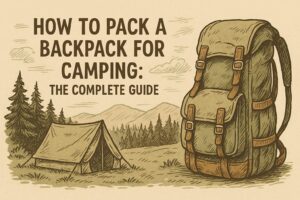Packing a backpack correctly can make or break your camping experience. A well-packed backpack ensures you stay comfortable, balanced, and organized on the trail. Whether you’re preparing for your first Scout camping trip or gearing up for a high-adventure trek, this guide will show you how to pack a backpack for camping the right way.
Why Proper Backpack Packing Matters
When your backpack is packed properly:
- Weight is distributed evenly, reducing fatigue.
- Important items are easily accessible.
- You stay organized, avoiding frustration when setting up camp.
- You prevent injuries caused by an unbalanced load.
Essential Gear Checklist
Before you start packing, make sure you have everything you need. Here’s a basic checklist for a typical camping trip:
- Tent (or tarp/shelter)
- Sleeping bag and sleeping pad
- Cooking gear (stove, fuel, pot, utensils)
- Food (meals and snacks)
- Water bottles and filtration system
- Clothing (layers for weather)
- Rain gear
- First aid kit
- Navigation tools (map, compass, GPS)
- Headlamp or flashlight (with extra batteries)
- Knife or multi-tool
- Fire-starting supplies (matches, lighter, firestarter)
- Toiletries (toothbrush, toothpaste, biodegradable soap)
- Trash bags (Leave No Trace!)
- Personal items (sunscreen, bug spray, whistle)
Tip: Always adjust your list based on the length of your trip, weather, and destination.
How to Organize Your Backpack
Think of your backpack in three main zones:
1. Bottom of the Pack (Lightweight, bulky items)
- Sleeping bag
- Sleeping pad (if packing inside)
- Camp pillow
- Spare clothing (not needed during the day)
2. Middle of the Pack (Heaviest items)
- Food bag
- Cooking gear
- Water reservoir (if using a hydration bladder)
Pack heavy items close to your spine to maintain balance.
3. Top of the Pack (Lightweight and important items)
- Rain jacket
- Insulating layer
- First aid kit
- Snacks
- Map and compass
- Toiletries
4. Accessory Pockets and External Gear
- Headlamp
- Knife
- Sunscreen and bug spray
- Water bottles (side pockets)
- Tent poles (side or under compression straps)
- Wet or smelly items (outside in mesh pockets)
Pro Tip: Keep items you’ll use throughout the day within easy reach.
Step-by-Step: How to Pack a Backpack for Camping
- Lay everything out: Organize your gear before packing.
- Load the bottom: Stuff your sleeping bag first, then sleeping pad and extra clothes.
- Pack the heaviest gear in the middle: Food and cooking gear go close to your back.
- Fill the top with lighter gear: Keep rain gear, a fleece jacket, and first aid handy.
- Use accessory pockets: Store quick-access items in hip belt pockets, lid pockets, and side mesh.
- Attach larger gear outside: If needed, strap tent poles, wet rainfly, or foam pads externally.
- Tighten compression straps: Pull everything tight to keep the load stable.
- Adjust and fit the backpack: Adjust shoulder straps, hip belt, and sternum strap for comfort.
Packing Tips for Maximum Comfort
- Balance the load: Heavy items should be centered and close to your back.
- Distribute weight evenly: Avoid making one side heavier than the other.
- Minimize dangly gear: Secure everything tightly to avoid swinging loads.
- Pack smart for weather: If rain is possible, line your pack with a trash compactor bag to keep gear dry.
- Test the fit: Walk around your house or neighborhood with the loaded pack and adjust as needed.
Common Mistakes to Avoid
- Overpacking unnecessary gear
- Placing heavy items far from your back
- Forgetting essential items like rain gear or first aid kit
- Leaving loose straps hanging
- Ignoring backpack fit adjustments
Conclusion
Learning how to pack a backpack for camping is a skill that gets better with practice. A properly packed backpack improves your balance, energy levels, and overall comfort on the trail. Remember to plan ahead, pack smart, and adjust your gear for every trip.
For more outdoor tips and Scouting advice, check out our full guide to How to Tie Every Scouting Knot!





